The Great Divide Mountain Bike Route (GDMBR) whispered promises of connection as my tires traced its path, a welcome contrast to a year of solitude that had ignited a yearning for the camaraderie found on well-trodden trails. Every cyclist I encountered became a cherished conversation, each tire track in the dust a comforting sign of shared journeys, and even the matter-of-fact nods from store clerks, unfazed by my arms overflowing with gas station delicacies, spoke of a familiar rhythm on this renowned bike route.
In 2021 alone, I was one among thousands who ventured onto the GDMBR. My experience, statistically speaking, was quite typical. Yet, the transformative nature of a long journey elevates every traveler to the status of an expert. After conquering 2,700 miles, 1,600 of them solo and 1,100 alongside my husband, I’ve become intimately acquainted with the Divide’s unique character. I could expound at length on the diverse textures of its gravel (“chunky with a washboard undertone, lacking a smooth finish”), the predictably unpredictable moods of Rocky Mountain weather, and the fluctuating availability of that quintessential cyclist fuel – the cheeseburger.
Imagine we’re sharing stories around a crackling campfire, and the Great Divide sparks your curiosity. The advice I’d offer, distilled into this article, proved instrumental in shaping the spirit and tempo of my own adventure. However, the beauty of the Divide lies in its embrace of diversity. It has been ridden in virtually every imaginable style and pace, on every conceivable bike, with gear ranging from minimalist to maximalist, and by cyclists of all experience levels. Therefore, consider this advice as an invitation – a starting point to contemplate what you seek from your ride, coupled with practical insights to help you bring that vision to life on this incredible bike route.
Defy Convention: Consider a Northbound Journey
The conventional GDMBR narrative unfolds southbound, tracing a path from Canada to Mexico. The allure is clear: starting amidst mountains and descending towards the desert – a predominantly downhill experience, right? (A playful notion, certainly not reality!).
However, a growing number of adventurous spirits, myself included, are embracing the northbound (NOBO) route, starting in Antelope Wells, NM, and pedaling towards Canada, like salmon swimming upstream. My motivation was simple: to reach the Canadian border shortly after its reopening to tourists after a prolonged closure.
Initial research painted a daunting picture of northbound travel. Seasoned bikepackers cautioned about prevailing north-to-south winds and steeper climbs on the southern sections. Headwinds and unrideable ascents? It sounded like a relentless battle.
Explore the Great Divide Mountain Bike Route for your next adventure.
Yet, my northbound experience defied these grim forecasts. While I battled headwinds across parts of Wyoming and southern Montana and certainly encountered challenging climbs requiring me to push my bike, these hardships were balanced by stretches of favorable weather and gentler inclines. Conversations with southbound riders revealed a similar story – they too faced headwinds and steep climbs. It appears that for those of us not racing against the clock, the perceived northbound-specific challenges are overshadowed by the inherent variability of the route itself.
Northbound riding presents unique advantages, even in years with open borders. An earlier start (late May or early June) allows you to enjoy a longer window before snow becomes a concern in the high mountains of southern Colorado. New Mexico’s remote and demanding terrain means you tackle significant early challenges: longer food and water carries and tougher climbs are conquered sooner. And the grand finale? You journey from the desert’s stark beauty to the majestic Canadian Rockies, culminating in the route’s most breathtaking mountain scenery.
Socially, northbound travel offers a distinct flavor. You might encounter a fellow northbounder every few days, creating fleeting connections. In contrast, during peak season, southbound riders become a more frequent sight, encountered every few hours. This fosters a sense of shared adventure, a feeling that many are out on the route, yet most encounters are brief. Is this a pro or con? It depends entirely on your preferred riding style.
Perhaps the most significant hurdle of northbound riding was the mental gymnastics of reversing directions and waypoints! Thankfully, the Adventure Cycling maps and GPX data are available in northbound versions. However, the McCoy Guidebook and many rider journals are oriented southbound. This mental reversal, however, can be a bonus, deepening your understanding of the bike route as you mentally reconstruct narratives and directions.
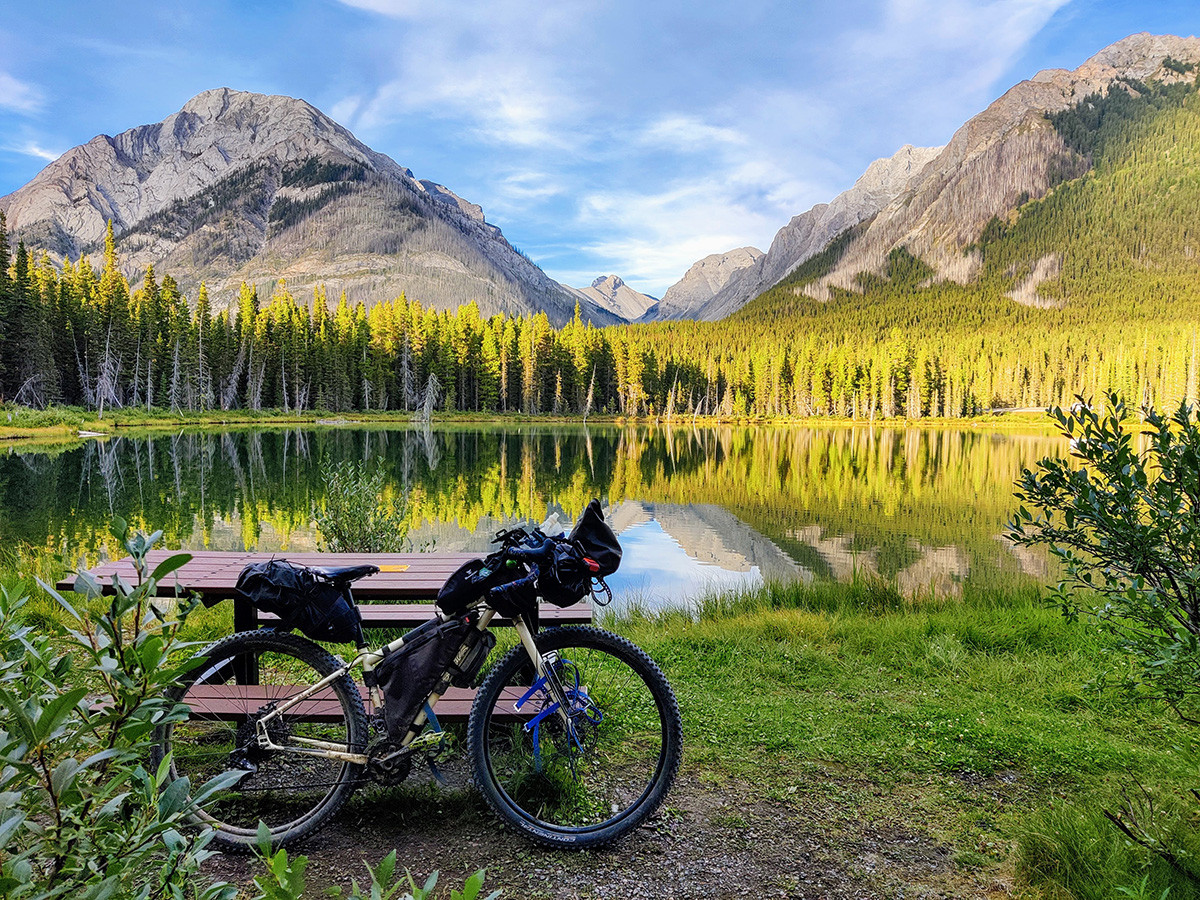 Alissa Bell enjoying her final night on the Great Divide Mountain Bike Route at Buller Lake, Alberta, a popular starting point for southbound riders.
Alissa Bell enjoying her final night on the Great Divide Mountain Bike Route at Buller Lake, Alberta, a popular starting point for southbound riders.
Alissa Bell’s last night on the Divide at Buller Lake, Alberta, near the starting point for many southbounders.
Time is Your Ally: Budget Generously
“How long will it take?” This is the ubiquitous question from aspiring GDMBR riders. A definitive answer is elusive, partly due to the incredible speed of Tour Divide racers. Winners often reach the Mexican border within two weeks of departing Banff – a pace unattainable, and likely unenjoyable, for most of us.
For those riding at a “touring pace” – prioritizing sleep and savoring meals without pedaling – the timeframe still varies widely. Fast-and-light enthusiasts might aim for a month, while those who relish leisurely side trips and relaxed mornings could easily fill three.
My own journey spanned two months, leaning towards the more relaxed end of the spectrum. I averaged 50 miles daily, incorporating a rest day roughly weekly, with days ranging from nearly 80 miles to a shorter 30. While I could have ridden faster, and sometimes felt the urge, the GDMBR reinforced a recurring lesson: the ideal pace for a long ride transcends mere physical endurance and mental fortitude.
If aggressive goals fuel your motivation, and you possess a limited memory for discomfort, compressing your GDMBR itinerary might be tempting. While I admire ambition, it’s crucial to acknowledge the trade-offs. For an unhurried experience, my advice is simple: add an extra week to your initial estimate, especially if long trips or unpaved riding are new to you.
This isn’t a reflection of your abilities. More time allows for slower riding, earlier stops, and ample rest. No shame in that! Logistically, extra time provides a buffer: weather storms, await post office openings, or address mechanical issues with less pressure.
Crucially, a flexible schedule allows you to fully embrace the simple joys of the Divide, experiences as unpredictable as the challenges. When leaving a perfect campsite feels like a wrench, or new-found friends invite you to linger in a charming town, you’ll have the freedom to indulge. Moments when I could discard daily mileage targets and seize unexpected opportunities felt like the ultimate luxury.
“But,” you might argue, “time off work/school/life is limited.” Understandable. The best approach is personal. Some adopt a “see how far I get” mindset, prioritizing a comfortable pace over completing the entire route. Others set ambitious goals and thrive on the challenge.
Section riding is an excellent compromise. Many section riders expressed a touch of envy, saying, “I wish I had time to ride the whole thing like you.” Yet, I often thought they had the better strategy. Section riders can choose optimal weather windows, enjoy many benefits of a thru-ride, and perhaps retain clearer memories of each day, in the long run.
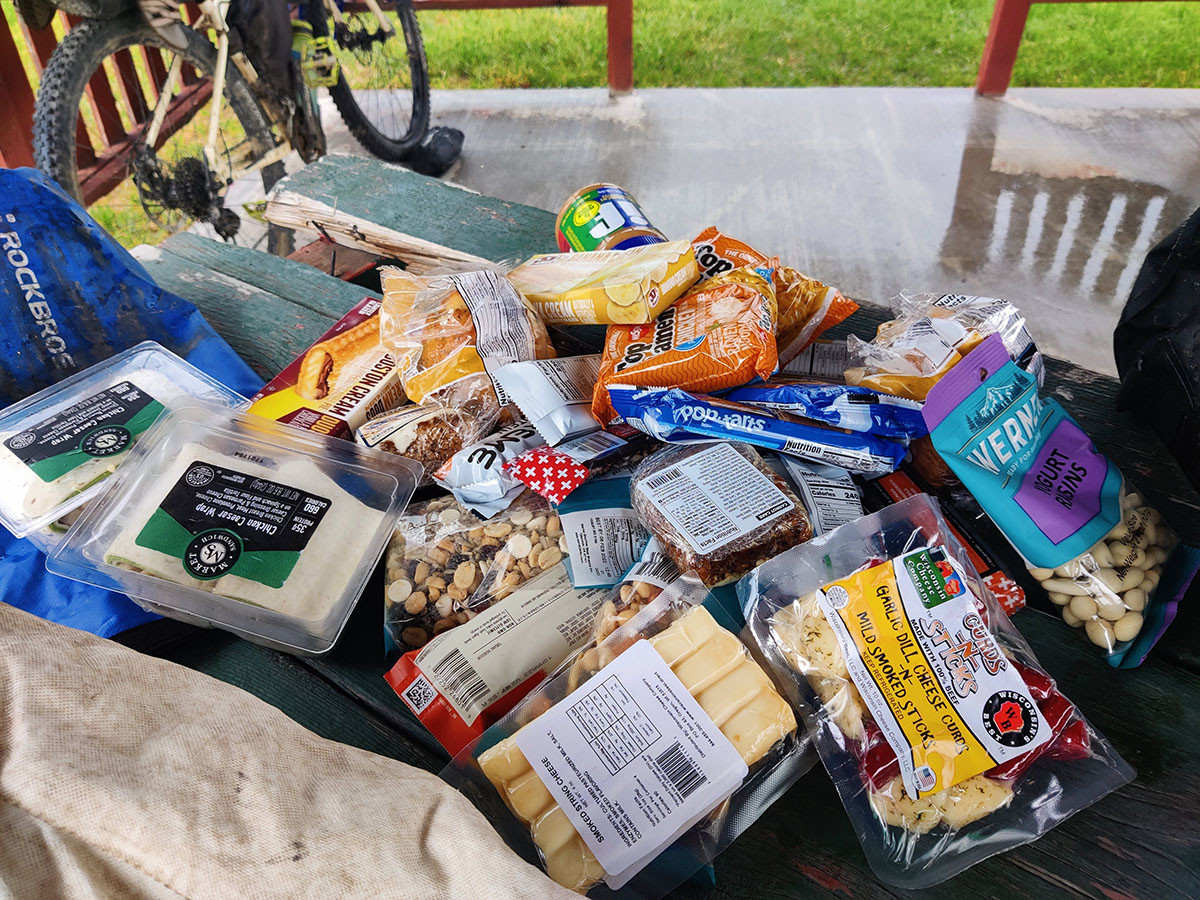 A picnic table laden with gas station food, featuring wraps, Pop-Tarts, and various packaged treats, illustrating the resupply options along the Great Divide Mountain Bike Route.
A picnic table laden with gas station food, featuring wraps, Pop-Tarts, and various packaged treats, illustrating the resupply options along the Great Divide Mountain Bike Route.
Stocking up on essential supplies at a gas station along the bike route.
Pack Light: Define Your “Essential”
On a sun-drenched Wyoming afternoon, tinged with smoky haze, I encountered two southbound riders within hours. One, in ultralight racing attire, seemed almost like a day-tripper. The other, a stark contrast, carried four fully loaded panniers. Yet, both were smiling. The GDMBR accommodates diverse gear setups.
My own approach – a lightweight-ish gear list packed into soft bikepacking bags – appeared to be a common middle ground. I also observed rear racks with smaller panniers, or simple dry sacks and straps. Fully loaded four-pannier setups were less frequent, and some such riders opted for paved alternates around rougher sections, but they too seemed to be enjoying their journeys. If you choose racks – a perfectly viable option – ensure they are robust and apply threadlocker to bolts to prevent loosening on demanding terrain.
The inherent constraint of bikepacking bags – their limited capacity – might be their greatest advantage. The argument for packing light becomes self-evident on the Gila’s steep climbs, the San Juans’ high passes, and Montana’s challenging trails. Yet, evenings at camp, ideally spent in relative comfort, are equally important. The elusive goal for any human-powered traveler remains: carry everything you need and need (or genuinely appreciate) everything you carry.
Especially on your first long-haul ride, discerning essential gear from superfluous items can be difficult. Fortunately, adjustments can be made en route. If an item remains unused for a week and isn’t intended for upcoming conditions, consider mailing it home from the next post office. Post offices are present in every town, offering boxes and tape. Simply arrive with your unwanted items and depart a few pounds lighter.
Similarly, if uncertain about a “nice-to-have” item during packing, leave it with a friend. You’ll likely forget about it once you start riding. If not, they can mail it to you via General Delivery. Better still, contact a business along your route (RV park, hostel, general store) and inquire about holding a package; their hours are often more flexible than post offices. This also works well for resupply packages of specialized food or consumables.
Before shipping every conceivable item, remember: you are not venturing into uncharted wilderness. You’ll encounter a small town every three to four days at most, often more frequently, and larger towns or cities every week or two. Food, toiletries, laundromats, bike parts, even outdoor gear are readily available, especially if you’re not overly particular.
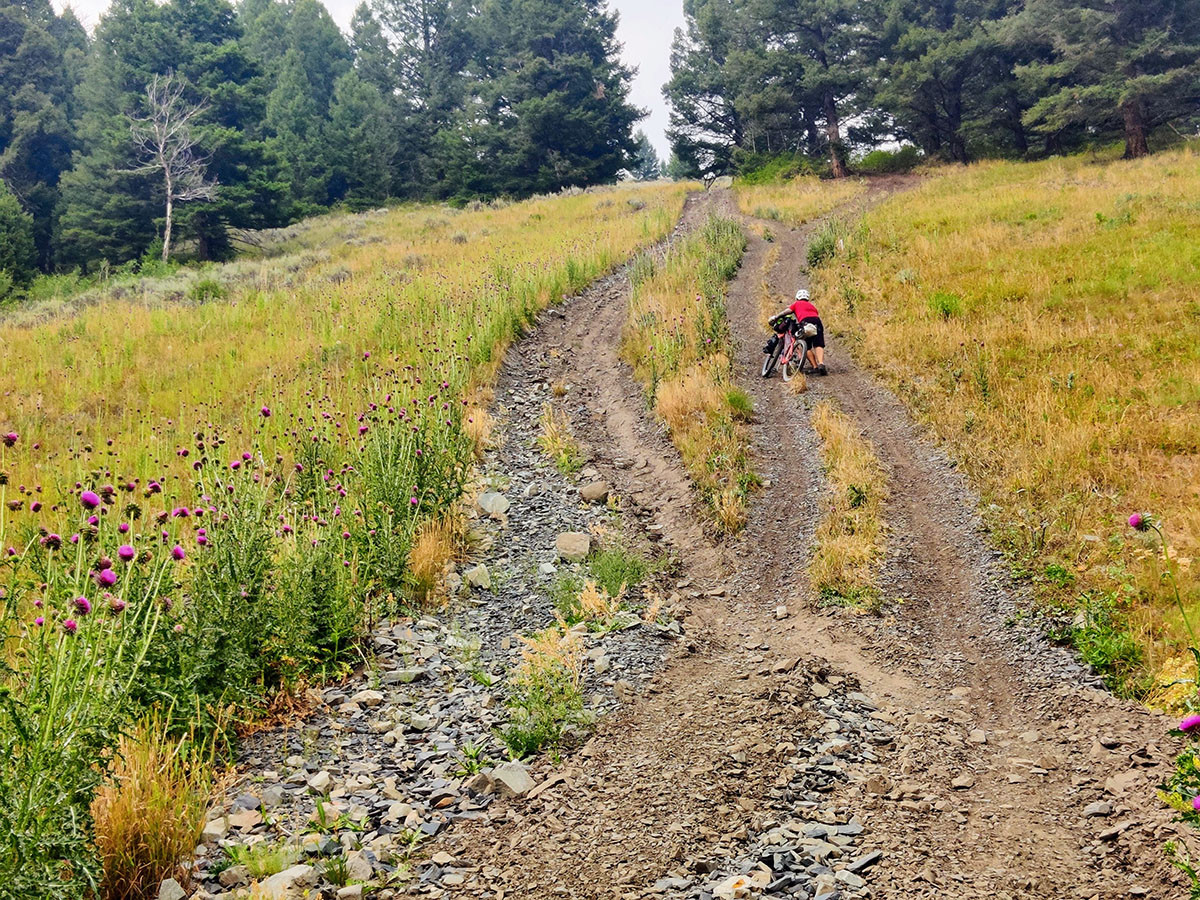 Alissa Bell pushing her bike up Fleecer Ridge in Montana, highlighting the hike-a-bike sections of the Great Divide Mountain Bike Route.
Alissa Bell pushing her bike up Fleecer Ridge in Montana, highlighting the hike-a-bike sections of the Great Divide Mountain Bike Route.
Getting acquainted with a hike-a-bike section on Fleecer Ridge in Montana.
Resist the Town Vortex: Embrace the Wild
After days immersed in nature, the allure of a small town oasis is undeniable. A restaurant, a motel – and the heavenly sight of a grocery store! – can feel like life’s only necessities.
Hence, the town vortex. Perhaps it’s the physical comforts, social interaction, or the sense of accomplishment in reaching a milestone. Or, more likely, it’s simply the food. Whatever the cause, extracting oneself from a pleasant town after completing chores can be challenging. Many GDMBR riders navigate from town to town, arriving late afternoon and succumbing to the comfort of a motel.
While I appreciate a comfy motel room – I truly do! – I suggest an alternative that served me well: try, at least occasionally, to ride through towns and camp beyond them. If you plan to arrive mid-day and mentally commit to departing by mid-afternoon (post-lunch, naturally), resisting the vortex becomes easier. You’ll also save significantly! Rooms can easily exceed $120 in some towns, and last-minute availability can be stressful.
Leaving many GDMBR towns places you on public land within 10-20 miles. The GDMBR traverses a wealth of National Forest land, ideal for free camping. I spent approximately half my nights on the Divide camping freely. Some nights were dictated by location – no towns within reach – but many were deliberate choices. Northern New Mexico and Colorado’s national forests, with their frequent, scenic, and grizzly-free camping options, were particularly delightful.
More subtly, increased camping frequency can profoundly impact your ride’s rhythm. For some, the bustle of towns can feel overwhelming after extended solitude. Listening to your mind and body allows you to use camping to establish your own pace. Town luxuries become even more appreciated after nights under the stars, and quiet nights in nature are even more rewarding after town time.
 A serene dispersed campsite in New Mexico, showcasing the beauty and solitude of wild camping along the Great Divide Mountain Bike Route.
A serene dispersed campsite in New Mexico, showcasing the beauty and solitude of wild camping along the Great Divide Mountain Bike Route.
The perfect dispersed campsite in New Mexico, offering solitude and stunning views on this incredible bike route.
Embrace Wild Camping: Venture Beyond Marked Spots
Dispersed camping, or wild camping, is my preferred camping style. It’s quieter than developed campgrounds, offers daily distance flexibility, and is free. Despite lacking picnic tables and toilets, I almost always choose a quiet dispersed site over a crowded campground.
Initially, I anticipated using the “informal campground” tent icons on Adventure Cycling GPX data for dispersed camping. However, these often turned out to be large dirt pullouts, sometimes occupied by RVs and littered with broken glass. I realized these spots cater to RVs and car campers; cyclists can find better. “Informal campground” simply indicates public land – National Forest or Bureau of Land Management – where dispersed camping is legal. If the marked spot lacks appeal, better options likely exist nearby.
Especially when riding solo, road invisibility is key to restful nights. While most people are considerate, primal instincts run deep. I sleep better when not wondering at 2 AM if passing truck drivers noticed my tent. So, I nestle into the landscape – atop a small hill, in a shallow ravine, or deep within sparse trees off faint tracks – relishing the feeling of merging with nature for the night. If concealment is challenging, camping on inside curves and uphill from the road is helpful, minimizing headlight exposure.
A crucial reminder, surely familiar: Leave No Trace principles are vital for this camping style. This includes pitching tents on durable surfaces like dirt or pine needles, not living vegetation; skipping campfires without existing rings or during fire bans; packing out all trash and food; and digging 8-inch catholes if pit toilets are unavailable. Given the GDMBR’s bear country, bear-aware camping practices are also essential.
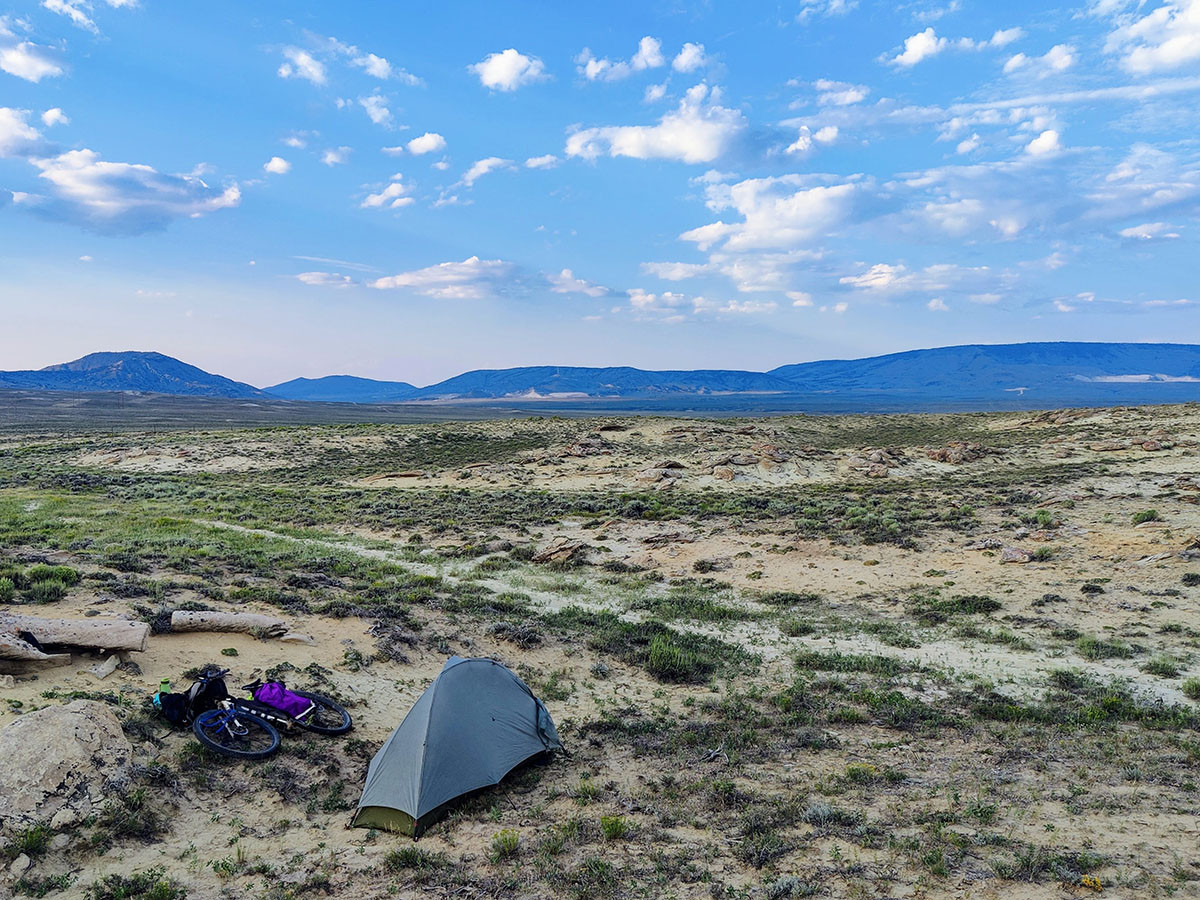 Dispersed camping in the Great Basin of Wyoming, illustrating the vast and varied landscapes encountered along the Great Divide Mountain Bike Route.
Dispersed camping in the Great Basin of Wyoming, illustrating the vast and varied landscapes encountered along the Great Divide Mountain Bike Route.
Dispersed camping under the vast sky in the Great Basin of Wyoming.
Flexibility is Key: Adapt to the Route’s Variety
The GDMBR is a constantly evolving mosaic of roads, communities, and terrain. This keeps the journey engaging across thousands of miles but demands attentiveness. Twice-daily restaurants transition to three-day food carries (and back), abundant water sources yield to extended dry stretches (not the Basin, surprisingly), and plentiful camping abruptly vanishes into long sections of private land. Just when you think you’ve grasped the pattern, expect a surprise.
The best advice: embrace just-in-time planning. Meticulously pre-planning each day is futile and frustrating, but unpreparedness is equally undesirable. Even experienced riders benefit from reminding themselves of this balance. To structure this process, answer these questions at each town stop or shortly before:
- How many days until the next food resupply? Any restaurants in between?
- How far to the next water source? Any extended water carries approaching?
- Potential campsites for the next few nights? Long stretches of private land ahead?
- Weather forecast?
- Route closures or detours in the upcoming section?
- Motel reservations needed in the next town? (Consider booking ahead if it’s a busy location.)
Just-in-time planning is crucial on the route, but smart gear choices before departure are equally vital. Most importantly, you need flexible cargo capacity for variable food and water needs. I typically carried 1-2 days of food, extending to four in northern New Mexico. Two liters of water sufficed in most areas, but I carried six in the Great Basin and a challenging eight in the Gila National Forest south of Pie Town, NM. Specifics depend on your pace, direction, and season, but all riders encounter diverse resupply demands.
My strategy involved two 5L dry bags strapped to fork-mounted gear cages. These expanded to maximum capacity for food and water and compressed when less was needed. Extra water capacity came from two collapsible Platypus bottles and my water filter’s 3L dirty bag. For moments when bike-packing became cumbersome, a small stuffable backpack proved invaluable.
While fluctuating conditions kept me mentally engaged, there was also an emotional liberation. Weather, terrain, and my own mood ebbed and flowed daily, from mountain pass to mountain pass. Just as perfect, easy days could turn challenging, challenges always resolved. The more I relaxed into the ride’s rhythm, the more contentment I found.
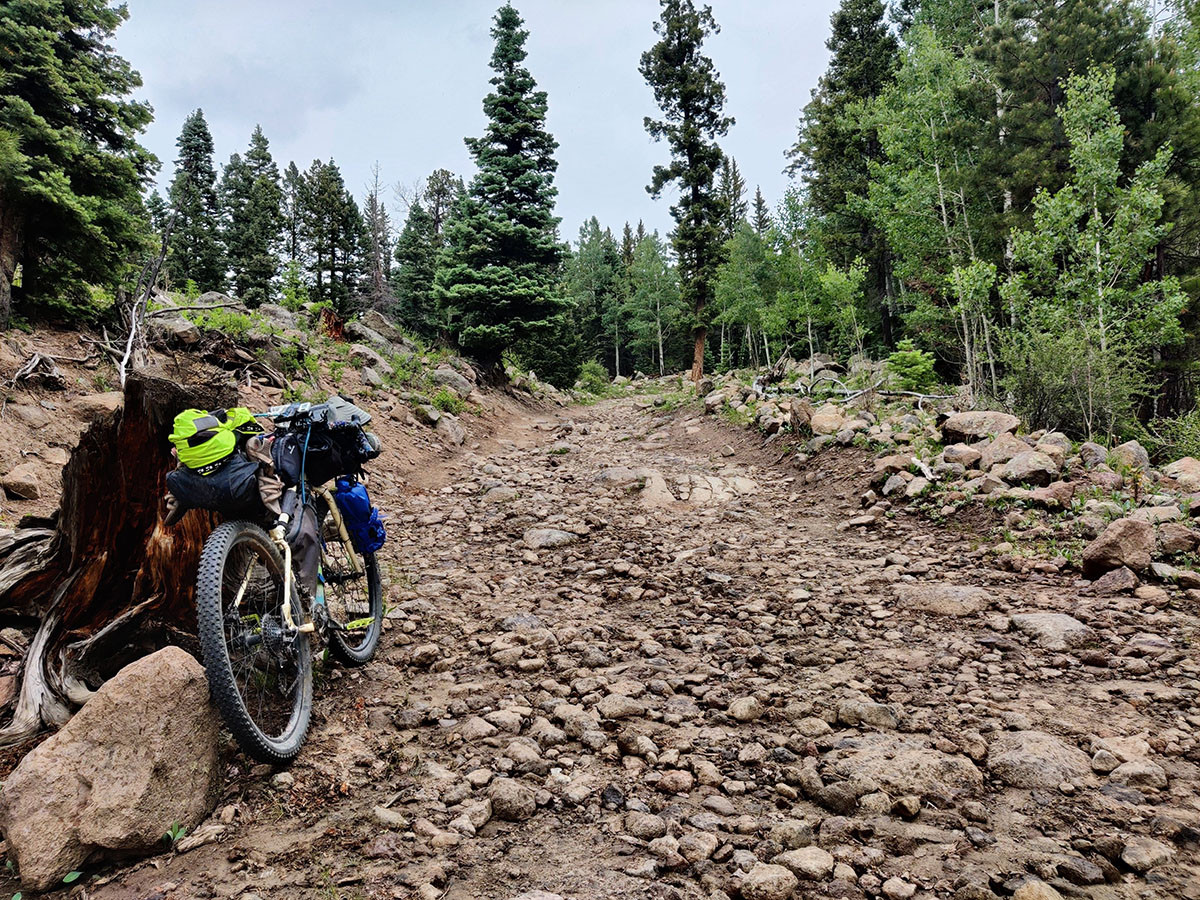 A rough and rocky road south of Abiquiu, New Mexico, illustrating the varied terrain and potential for slow travel on the Great Divide Mountain Bike Route.
A rough and rocky road south of Abiquiu, New Mexico, illustrating the varied terrain and potential for slow travel on the Great Divide Mountain Bike Route.
A challenging, unpaved road south of Abiquiu, New Mexico, demanding slow and careful riding.
Final Tips for Your Bike Route Adventure
Here are a few more practical tips to store in your mental seat bag for your GDMBR journey:
Document your journey: Keep daily notes and photos, capturing not just scenery, but also people you meet and places you stay. Early days on the Divide seem unforgettable, but weeks later, they can blur.
Prioritize healthy food when available: In some sections, gas station fare becomes the norm for days. Even delicious town meals can lose appeal after a while. When you find a well-stocked grocery, listen to your body’s cravings. A crisp salad might be surprisingly appealing!
Explore the best food options for your next bicycle tour to stay energized and healthy on the road.
Embrace cyclist-specific lodging and camping: Iconic GDMBR spots like Toaster House, Brush Mountain Lodge, and Llama Farm are renowned for hospitality and community. Many of my deepest conversations and strongest connections occurred at these gatherings. Even when initially tempted to camp solo, I always left feeling recharged and grateful for stopping.
Befriend hike-a-bike: There’s no shame in walking sections on the Divide. Pushing your bike uphill conserves energy, prevents injuries, and provides a different range of motion for tired muscles.
Stay informed on route conditions: The GDMBR is a vast, dynamic landscape. Conditions change rapidly. These Facebook groups and this one are active sources for water updates, fire closures, trail magic, lost gear, and more. Also, check Adventure Cycling addenda for route detours and service updates.
Above all, minimize stress! With such a well-documented bike route, feeling pressure to know everything beforehand is easy. Absorb information for planning and enjoyment, but avoid feeling obligated to implement every detail. After all, initial imperfections are part of the adventure!
There’s nothing quite like the feeling of mounting your bike, pointing your wheels towards a distant border, and pedaling into the unknown. Trust in your innate resilience and resourcefulness to navigate whatever lies ahead. May the winds be favorable, the air clear, and the climbs gentle. And even when those conditions aren’t met, may you still discover confidence, contentment, and community on the Great Divide, your chosen bike route.
